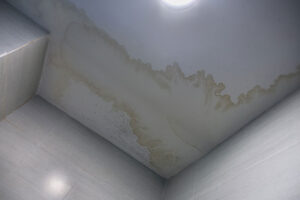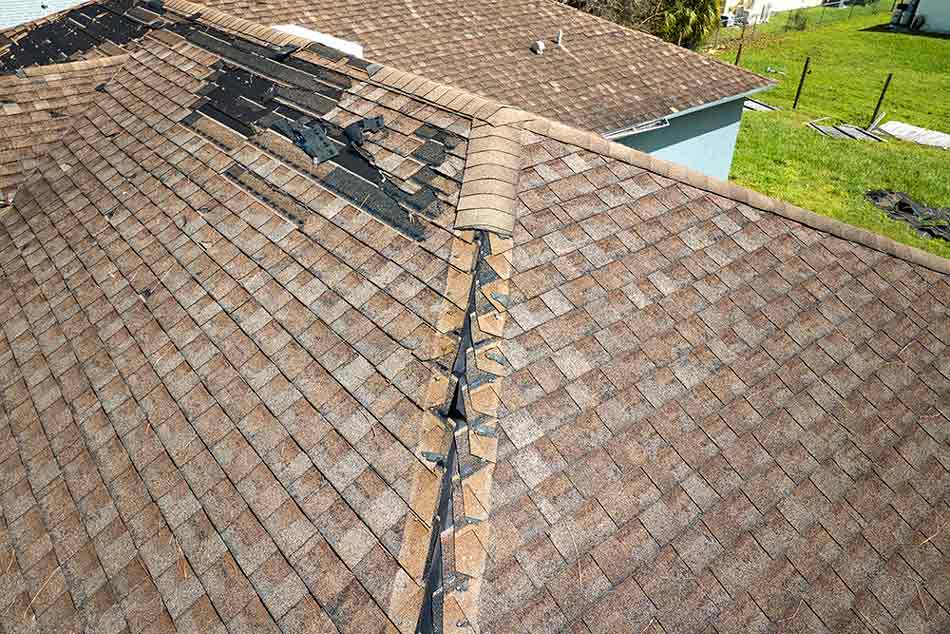Roof leaks – just the mention of those two words is enough to send a shiver down any homeowner’s spine. The inconvenience, potential damage, and the cost of repairs can all add up to a stressful situation.
Understanding how to identify a roof leak is not just important, it’s crucial. Doing so can prevent further damage to your home and save you a significant amount of money in the long run.
But how do you identify a roof leak before it becomes a significant problem?
Here’s what you need to know to spot a roof leak before it wreaks havoc on your home.
Interior Signs of Roof Leaks
The following are all interior indications of a potential roof leak. If you notice any of these signs, your roof likely has a leak and you should seek professional help.

Water Stains
Water stains are perhaps the most common sign of a roof leak, appearing as dark brown spots or ring-shaped marks on your ceilings or walls.
However, it’s important to note that water stains don’t always indicate the exact location of the leak itself. Water can travel along rafters or beams before dripping down, making it challenging to pinpoint the source of the leak.
Mould and Mildew Growth
The presence of mould or mildew in your home can clearly indicate a moisture issue, often resulting from a roof leak. Not only is mould unsightly, but it can also pose serious health risks to you and your family, such as respiratory problems, allergies, and even infections. Be sure to check areas prone to moisture, such as attics and bathrooms, and around suspected leak points.
Damp and Musty Odours
Persistent musty smells lingering in your home can be another telltale sign of a hidden roof leak. These odours often stem from dampness caused by water infiltration.
Other signs of a hidden roof leak include unexplained high humidity in your home, peeling paint or wallpaper, or a sudden increase in your water bill. Take the time to inspect your attic and crawlspaces for any signs of dampness or moisture.
Sagging Ceilings or Walls
Sagging ceilings or walls are a more serious sign of a roof leak, indicating water accumulation and potential structural damage.
If you notice any sagging, it’s crucial to take immediate action to address the leak and prevent further harm to your home’s integrity. Ignoring a sagging ceiling or wall can lead to more extensive damage, such as a collapsed ceiling or wall, so it’s important to take action at the first sign of sagging.
Exterior Signs of Roof Leaks
These are the exterior clues signalling potential roof leaks. Again, if you notice any of these signs, it’s best to contact a roofing professional right away.

Missing or Damaged Shingles
Exposed areas where shingles are missing or damaged can serve as entry points for water, leading to roof leaks. Look for any signs of wear and tear on your shingles, especially after severe weather events.
Granule Buildup in Gutters
Shingle granules act as a protective layer for your roof, and excessive loss of granules can indicate aging and potential vulnerability to leaks. Regularly check your gutters for signs of granule accumulation, which could signal the need for a roof replacement.
Damaged Flashing
Flashing, typically found around chimneys, skylights, and vents, is crucial in preventing water intrusion. Damaged or deteriorating flashing can compromise the integrity of your roof, leading to leaks. Be sure to inspect flashing regularly for any signs of wear or damage.
Visible Roof Damage
Direct damage to your roof, such as broken vents or loose antennas, can also result in leaks during heavy rain or snowfall. Take the time to visually inspect your roof for any signs of damage and address them promptly to prevent leaks.
Identifying the Leak Source
Navigate the process of pinpointing the elusive source of roof leaks, whether through meticulous attic inspections or careful exterior examinations, ensuring effective and targeted repair strategies.
Attic Inspection
Safety should always be your top priority when conducting an attic roof inspection. In the attic, trace water stains back to their source on the roof, looking for any signs of damage or deterioration.
Exterior Inspection
Wait for appropriate weather conditions before conducting an exterior roof inspection. Be sure to take safety precautions, such as avoiding steep slopes and using a spotter. Visually inspect common leak points such as flashing, chimneys, and valleys for any signs of damage or deterioration.
Immediate Actions to Take
In the event of a roof leak, it’s important to take immediate action to mitigate damage to your home. Consider placing a bucket to catch drips under the leak (for interior leaks) or tarping the roof to prevent further water infiltration.
However, it’s crucial to avoid permanent DIY repairs, as these can often do more harm than good, potentially leading to more extensive damage and higher repair costs.
When to Call a Professional
Remember, while temporary measures can help in the short term, it’s always reassuring to know that professional help is available. A qualified roofing contractor can accurately identify the source of the leak and perform the necessary repairs, ensuring your safety and the integrity of your home.
Key Takeaways
Regular roof inspections and early leak detection are essential for maintaining the integrity of your home and avoiding costly repairs down the line. The expertise of a professional roofing contractor is invaluable when it comes to addressing roof leaks. By promptly identifying and addressing leaks, you can protect your home and ensure its longevity for years to come.
Proactive roof maintenance can save you time, money, and headaches in the long run. Don’t wait until it’s too late – keep an eye out for signs of leaks inside and outside your home, and don’t hesitate to call a professional if you suspect a problem. With the right knowledge and assistance, you can safeguard your home against the damaging effects of roof leaks. Ready to tackle that leaky roof? Contact our professional roofing team in Kingston for a consultation or request a quote online today.

